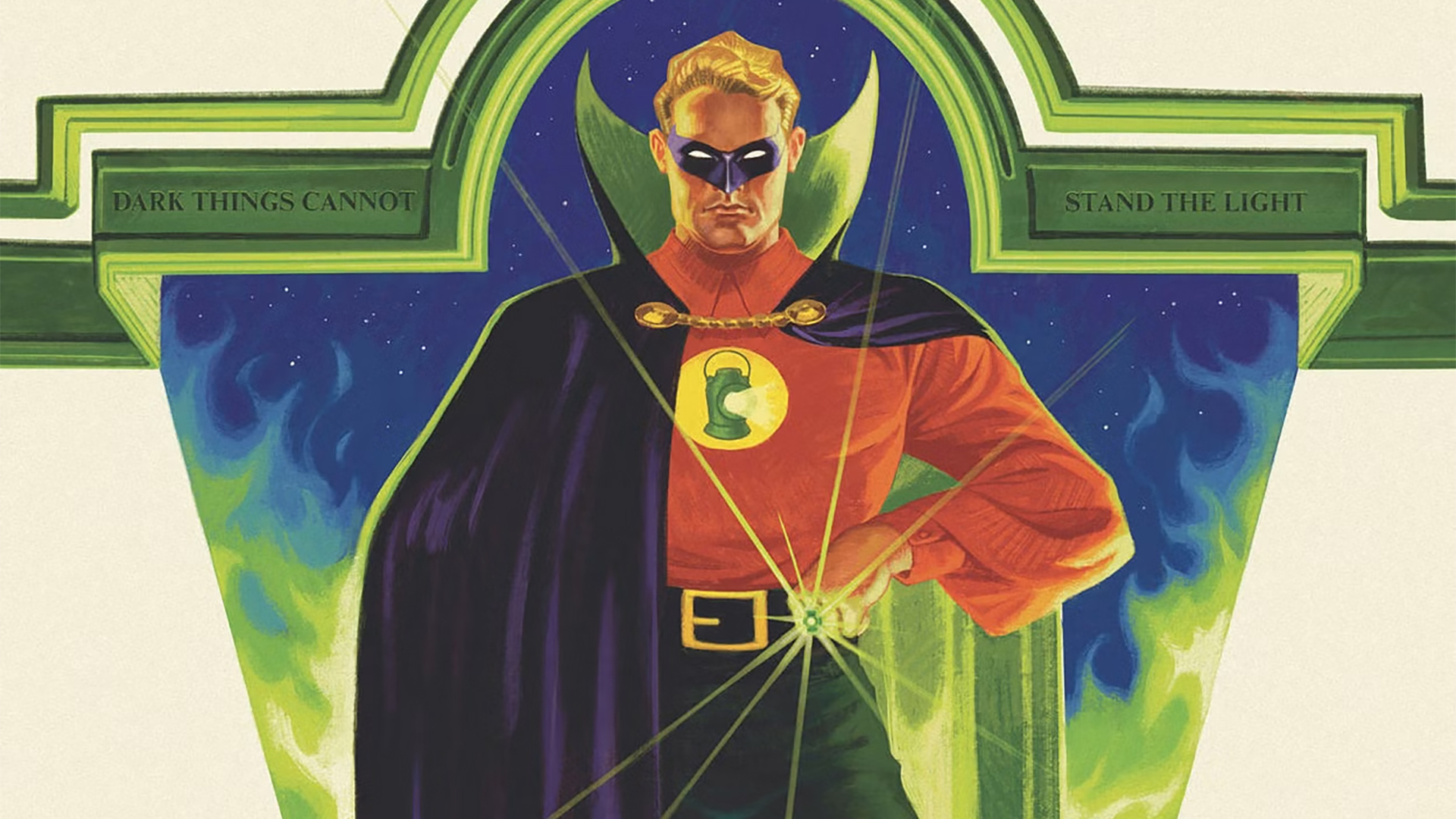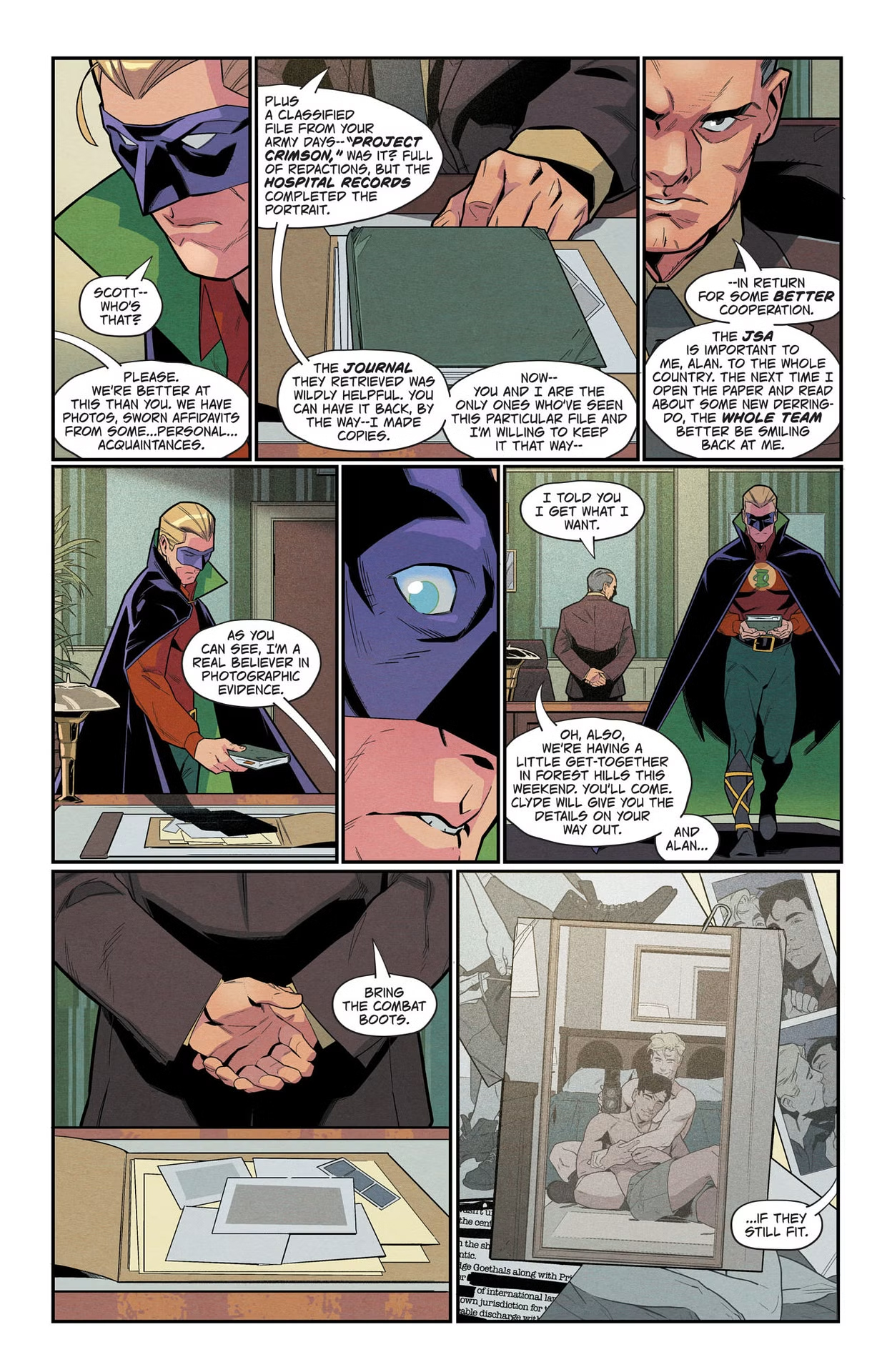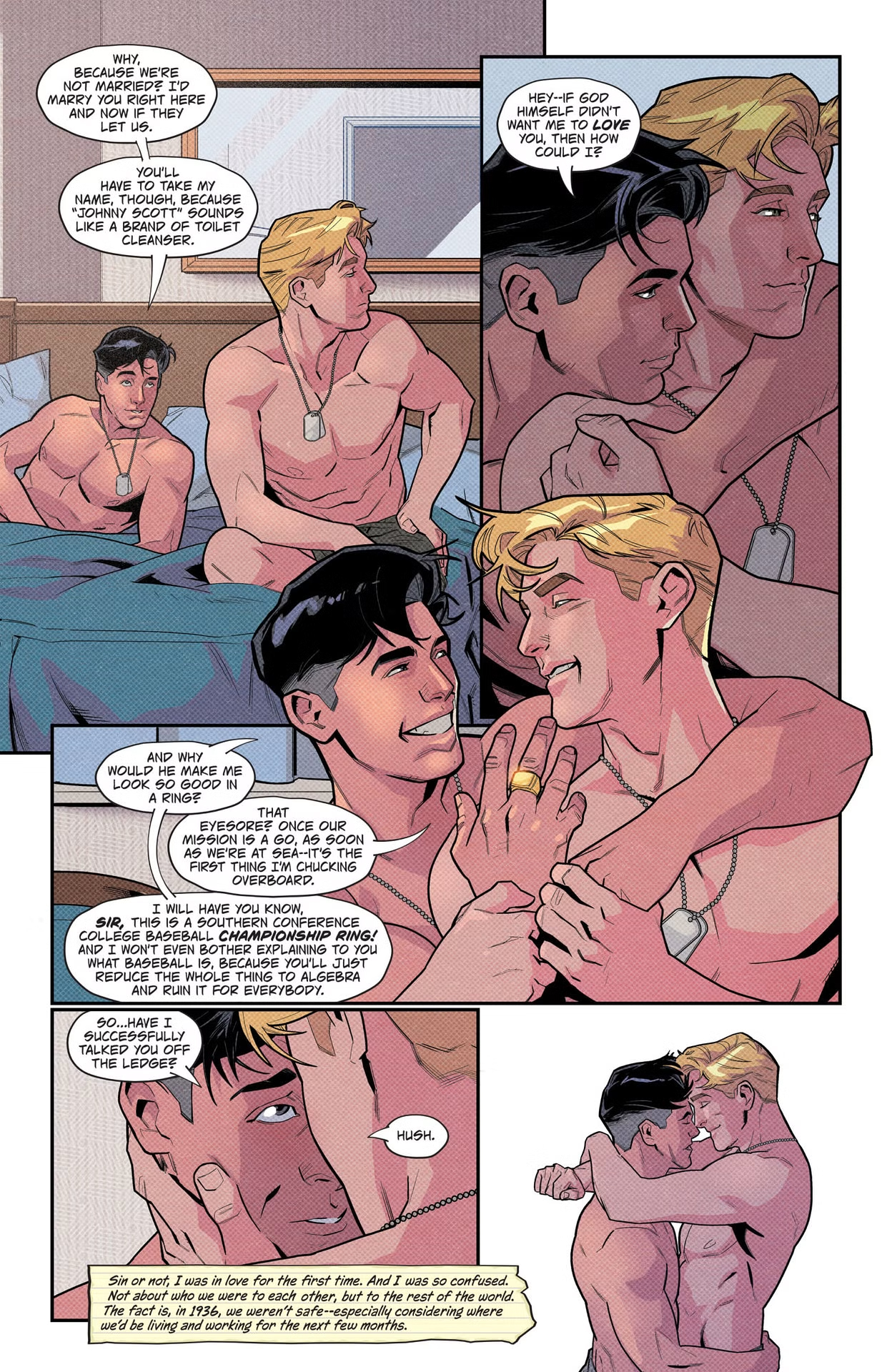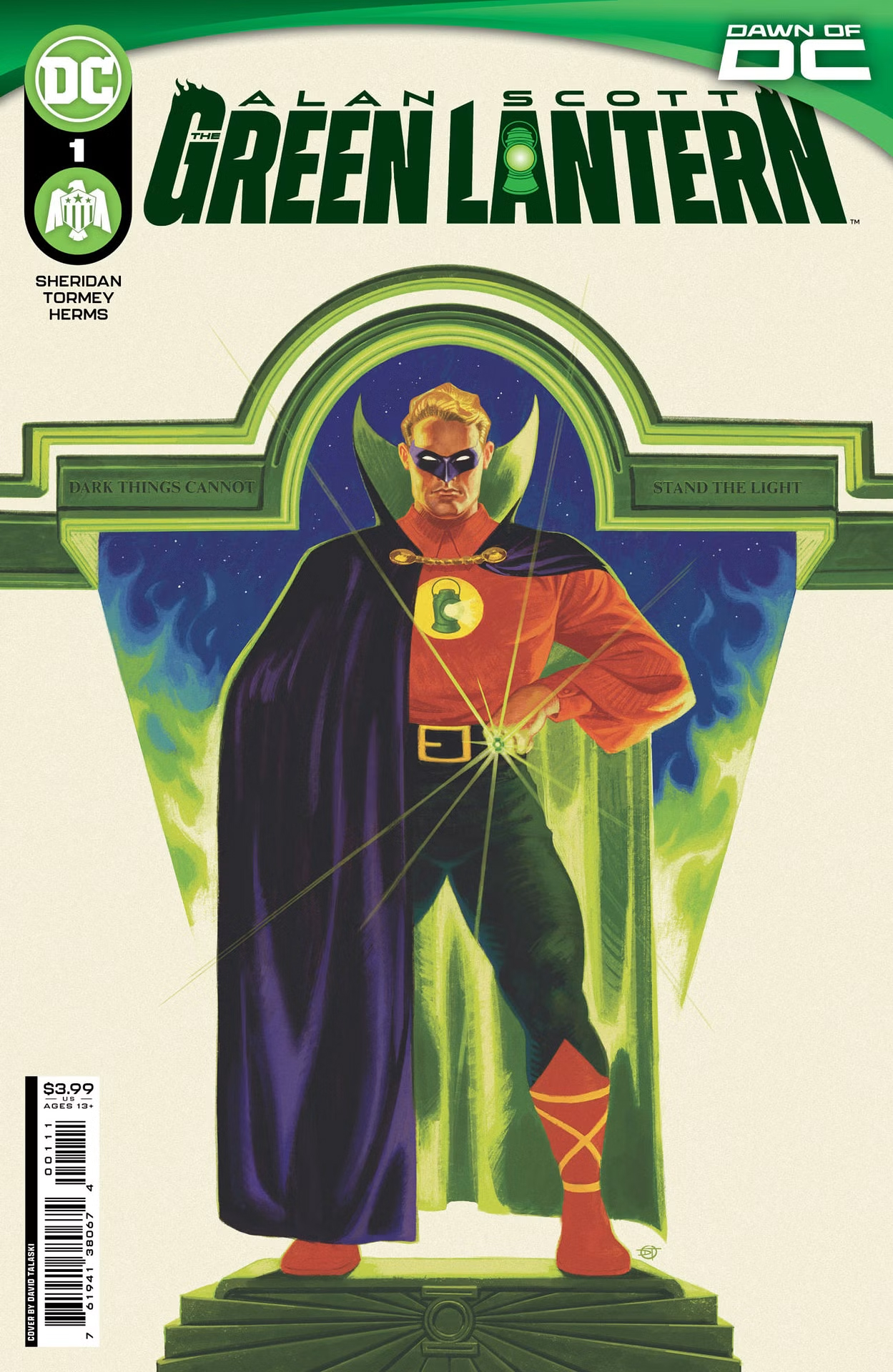
Alan Scott, the Golden Age Green Lantern, made his comic debut back in 1941. But thanks to the modern story development of Alan Scott coming out as gay, he remains surprisingly relevant to the DC Universe. And now, he's taking the spotlight in his own limited series as part of DC's New Golden Age.
The New Golden Age revisits the histories of classic DC heroes of the '40s and '50s, adding in new elements that connect them more strongly to the legacy of the DC Universe. For Alan Scott: The Green Lantern, writer Tim Sheridan and artist Cian Tormey are leaning into that concept, bringing Alan Scott's previously unseen enemy the Golden Age Red Lantern back into his timeline while also exploring Alan's sexuality and what that meant for someone in the '40s.
With Alan Scott #1 now on stands and #2 scheduled for release on November 28, Newsarama spoke with Sheridan about how he's integrating new elements into Alan's classic story, and digging deeper into the more personal untold history of the hero.
Newsarama: Tim, first off, I want to say I really enjoyed this first issue of Alan Scott. I think it's interesting to go back to his origin with the context of the modern day. That said, this is a bit of a different take from what we've seen before. How does the concept of the New Golden Age inform Alan Scott as a character, and this title as a whole going forward?

Tim Sheridan: Geoff Johns and I were working on Flashpoint Beyond, and he started talking about some of his ideas that would relate to the New Golden Age, having some characters that were removed from the canon being placed back into the timeline. That was so much fun, and after we planted those seeds in Flashpoint Beyond, Geoff called me and said, "I think you need to do an Alan Scott book about his origins, that shows him as a closeted gay man in the '40s."
We also talked about the Red Lantern, the Soviet answer to the Green Lantern who we should have known about all these years, but who was removed and then reinserted back into the timeline. So now I get to go back and tell Alan's story with a new layer of having this other character in his life, an arch-nemesis who is going to be a very consequential person in Alan's life. There's no Red Lantern Corps yet - the story takes place in 1941. So that was a big storytelling opportunity.
Rarely do you get an opportunity to do something that isn't a retcon, that's just sort of adding more layers to the story as we know it. That's what really excited me about it, in addition to the fact that I'm given the opportunity to write a very authentic story about, you know, a queer character in the queer experience, certainly during a very tragic time for queer people.
Since you brought up the Red Lantern, I'll go ahead and ask you right away… Is there a connection between the Crimson Flame and the Emerald Flame in connection to the Red and the Green from Animal Man and Swamp Thing? There's a vibe I'm getting from the story. Is that something intentional?

You know, I'm not going to spoil anything about the origins of the Crimson Flame, or why it's there. But I think the important thing to know is that, regardless of where it comes from, this is an almost equal and opposite force to the Emerald Flame of Life. And this is something that is inextricably tied to the power of the Green Lantern.
And that means, you know, that these two are, in every sense of the word, arch-nemeses, the way that Joker and Batman are tied together for all time, that's how these two are tied together - the Emerald flame, the Crimson Flame, the Red Lantern, and the Green Lantern.
So far, this seems to be the story of how Alan Scott got his willpower, the source of strength for his Green Lantern ring. How does that concept of willpower, the power that it takes to wield the Emerald Flame, inform both Alan Scott as a character, and the narrative of the story?
That's such a good question. You know, when I pitched this story, I talked about the amount of willpower it takes for a man like Alan Scott in 1941 to not be who he really is, who he was born to be. And what it means when that willpower is used for something that can be not so good, like staying in the closet, versus something really amazing and good, like being the Green Lantern. I'm not really putting too fine a point on that in the story. I'm just sort of trusting that it's there and that it will play out. The fact that you asked the question, it's very encouraging to me that it's coming through, that's great.
I don't know if you have the internet [laughs], but there are people who are not thrilled that Alan Scott came out of the closet. But I think your question really shows why this is such a rich point of story for a character like the Green Lantern, Alan Scott.

We're also telling a story about a man whose secret identity has a secret identity. And what does that mean? And how does he reconcile that? And how does he become the Green Lantern that we all know and love? How did he become part of the JSA that we all know and love?
There's so much opportunity to look at the concept of things like willpower and fear through the lens of a closeted hero in the '40s who just joined a super team, and who feels he can't get close to the team because he's worried that the laws of the day concerning what he does in his bedroom will fall back on them and hurt them in some way. Fear, willpower, these are obviously hallmarks of a Green Lantern story, and I think they're present in this one.
As both a queer person who came out as an adult and a lifelong Alan Scott fan, I really appreciate how definitively queer this story is. I will say, I think it's a little shocking how heavy and honest you're able to get about what it was like culturally to be gay at a time when that was socially unacceptable and often punishable. You're even digging into conversion therapy at Arkham Asylum. That's heavy. How did you find the balance of being starkly honest about those things while also embracing the vaseline-smeared lens of the Golden Age that we often see?
First of all, I'm amazed at how, when you go back and read Alan's original stories in All-American Comics, so much of what we're doing is not rewriting the story. We're just sort of adding more texture, adding more layers. But it all still mostly fits with what we canonically know - aside from the small changes that happen when you insert someone's arch-nemesis back into their timeline. I mostly try to stay true to what we've read, so I've been amazed at how well this layers right into Alan's story.
In terms of the balance, it was important for me, if I was going to do this, to tell this story in the most authentic way that I could, which means there's going to be some horrific stuff at the beginning of the story.

This is a story about a man coming out of the darkness into the light. So we have to start in the darkness. We have to see what that is. And there's unfortunately very real darkness in that time period for people like Alan. And I have to tell you, it's still here. All over the world. There are people who are going through the things that Alan goes through in the '30s and '40s in this story.
I wish I could say that this was a historical document, that we're looking back at something that we all truly overcame. But no, this to me is a story that has to be told because it's still happening every day.
You said this is a very queer story. And to queer readers, they'll hear that and be like, "Great, that's exciting." And there are a lot of people who mean well, who will hear that and think "Oh, maybe this story isn't for me."
Let me tell you, it is. Because if there's any hope for any of us to learn more about each other, to love each other a little bit more, we have to tell our stories, and we have to tell them to each other in the most real and authentic ways we can. It's the only way things get better.
That's what this story is all about. And it all plays out on this amazing cosmic sci-fi superhero action packed landscape, which is something we get to do in comics that we don't necessarily get to do anywhere else. And I'm just joyful and grateful that I get to be a part of it.
I'm the weird kid who has been reading Alan Scott comics since the '80s with All-Star Squadron, and loving the character. But there's something about him that's always felt a bit like a cipher, that, when the character came out, kind of all snapped into focus and made his personality feel a lot deeper in retrospect. What are your touchstones in building this version of Alan Scott, both as a superhero, and as a closeted gay man?

In terms of the character and the touchstones for the character, it's very simple. For me, with Alan Scott, we sort of know him in this silver fox grandfather kind of role. A mentor to all, steady hand kind of character. I don't think we could tell a story about a guy who is completely at sea - literally in the first issue - without knowing that he's going to evolve into that steady force, that beacon of light for not just the readers but for all the heroes that surround him, and those coming up after him.
When I get thinking about the big plot stuff, I want to figure out some things about his powers, and I want to explain some stuff and help make some connections that are ultimately in service of making the story fit even better into canon. I'm not into retcons. You know, that's not my thing. What I like is going back and looking at these characters at their core, then adding more layers of understanding of why they are who they are.
When you read actual Golden Age comics, there's not a lot of depth to the characters. They're great stories, they're fun. A lot of them are very repetitive, but they're great fun, especially for kids back then. Now, we get to take those stories and that raw material even further and to find the depth in them with new stories.
On a complete side note, what a great time to be a Green Lantern fan. It's incredibly rare to see three Green Lantern comics on the shelves at the same time. That doesn't happen all the time, and it's exciting to be a part of it.
It is cool that if you're a Green Lantern fan, you can kind of pick up and read the comic with the Green Lantern you love the most - even if it's Alan Scott, which is definitely rare.

I hope we have more people come to Alan Scott because of this story, either rediscover or discover him for the first time, and see his role in the Green Lantern mythology.
That's the big thing. I gotta tell you, you know, I'm not gonna spoil anything, but when this book is over, I'm laying down some stuff that is hopefully going to change the way you see Alan, and the way you see the Green Lantern Corps. It's that consequential.
We've only just scratched the surface of the potential of the Green Lanterns, when you think about it. They have this remarkable power set that is derived from all the magic in the universe, and all we really ever see them do is create green energy constructs. I think there's so much potential there, and we saw it in Alan's early days. There are things he could do that other Lanterns haven't done. So why is that, and what else can they do?
I want to talk about Cian Tormey and the rest of the art team, colorist Matt Herms and letterer Lucas Gattoni, because it's fantastic work, it's really engaging. One thing I really love is that it doesn't shy away from the romance scenes the way gay stories sometimes do. What's it been like working with Cian and the rest of the team?
Look, I mean, those scenes aren't explicit, you know. Those scenes are real, they're realistic. And that's the way we approached everything in this book. Authenticity and realism has to be our guide through this.
Cian got that right away, we didn't even have to have a conversation about it. He knew the tone we were going for. Happily, he's a guy who understands those types of scenes, and how that intimacy and those relationships are things you can bring out on the page.

The pinnacle for me is when Cian draws a panel, and I'm like "Oh, I can remove every balloon from this, every caption from this panel, because you said it all with a look. It's a real gift for a writer when an artist can bring that to the page. And let me say, his work is getting stronger and richer and more complex the more we get into this story, the more we move through this. It's a shame we only get to do six issues, because I can't imagine what this story would look like at 12 issues or beyond.
And Matt Herms, the colors are incredible. I love the way he's textured the flashback scenes. I've always had an issue with the way flashbacks have been done in any of my books. I'm always trying to make sure you can clearly delineate that we're in a flashback without having to throw up a banner with the year or whatever. Matt has just blown me away with how he's been able to do that.
Then there's Lucas Gattoni, who is just the greatest partner as a letterer that a writer could have. He's been a joy to work with. Every time I feel like we can't do something, I ask him, and he's like "Why yes, of course!" [laughs] And then he does it, and it's spectacular. It's really great to have an ally like that.
And speaking of allies, I have to bring up our editors Andrew Marino and Marquis Draper. We wouldn't have a book without them. They've been incredible allies. These are amazing people who understand the basics of story and they can leave all the complex queer theory to me. [laughs] And that's very freeing. It also keeps us focused on what's important, which is telling a great story.
What do you want to say to fans who are just getting into Alan Scott?
I want them to have a really great time reading the story! And hopefully people will look at Alan Scott and see that he can be a progenitor, not just for, you know, queer heroes, but that he is one of the forefathers of these great archetypal characters that we've come to know and love.
Alan Scott is one of the best Green Lanterns of all time.







